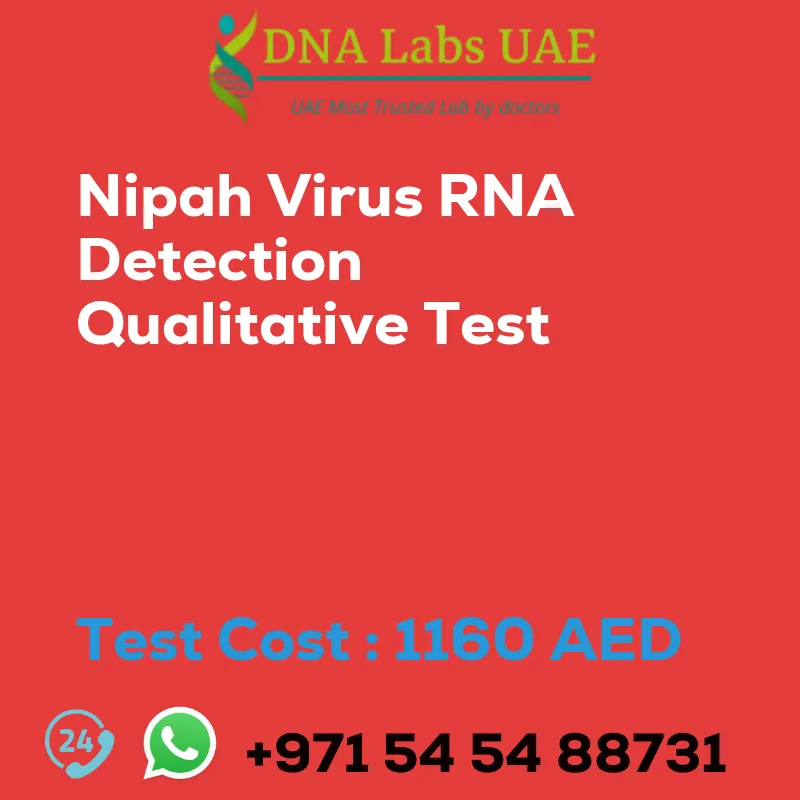Nipah Virus RNA Detection Qualitative Test
Cost: AED 1160.0
Test Name
Nipah Virus RNA Detection Qualitative Test
Components
Price: 1160.0 AED
Sample Condition
Whole Blood, serum, plasma, respiratory secretions, Urine, etc.
Report Delivery
4th Working Day Email: 48 hours. On phone: 36 hours
Method
Real Time PCR
Test Type
Viral
Doctor
Physician
Test Department
Genetics
Pre Test Information
Need to sign Consent document and bring any clinical history of patient for Nipah Virus (RNA Detection) Qualitative Test
Test Details
The Nipah virus (NiV) is an RNA virus that causes severe respiratory and neurological diseases in humans and animals. The detection of the Nipah virus RNA is crucial for early diagnosis and prompt implementation of control measures.
- Sample collection: Respiratory secretions, blood, cerebrospinal fluid, or other body fluids from suspected cases are collected using appropriate techniques and stored in appropriate containers.
- RNA extraction: The viral RNA is extracted from the collected samples using commercially available RNA extraction kits. This step involves breaking open the virus particles and separating the RNA from other cellular components.
- Reverse transcription: The extracted RNA is converted into complementary DNA (cDNA) using reverse transcriptase enzyme. This step is called reverse transcription, and it allows for the detection of RNA viruses using polymerase chain reaction (PCR) techniques.
- Polymerase chain reaction (PCR): The cDNA is then subjected to PCR amplification using specific primers that target the Nipah virus RNA. PCR is a technique that amplifies specific DNA sequences, allowing for the detection of the target virus.
- Gel electrophoresis: The PCR products are separated by size using gel electrophoresis. The amplified Nipah virus RNA fragments are visualized as bands on the gel.
- Detection: The presence of Nipah virus RNA is confirmed by comparing the size of the amplified fragments with a molecular weight marker. Positive samples show the presence of specific bands, indicating the presence of Nipah virus RNA.
- Interpretation: The results of the qualitative test are interpreted as positive or negative based on the presence or absence of specific bands on the gel. It is important to note that this qualitative test is a laboratory-based technique and requires specialized equipment and trained personnel to perform. Rapid diagnostic tests, such as antigen detection tests or nucleic acid amplification tests, may also be available for the qualitative detection of Nipah virus RNA in some settings. These tests provide quicker results and can be performed at the point of care.
| Test Name | Nipah Virus RNA Detection Qualitative Test |
|---|---|
| Components | |
| Price | 1160.0 AED |
| Sample Condition | Whole Blood, serum, plasma, respiratory secretions, Urine, etc. |
| Report Delivery | 4th Working Day Email : 48 hours.On phone : 36 hours |
| Method | Real Time PCR |
| Test type | Viral |
| Doctor | Physician |
| Test Department: | Genetics |
| Pre Test Information | Need to sign Consent document and bring any clinical history of patient forNipah Virus (RNA Detection) QualitativeTest |
| Test Details |
The Nipah virus (NiV) is an RNA virus that causes severe respiratory and neurological diseases in humans and animals. The detection of the Nipah virus RNA is crucial for early diagnosis and prompt implementation of control measures. The qualitative test for Nipah virus RNA detection involves the following steps: 1. Sample collection: Respiratory secretions, blood, cerebrospinal fluid, or other body fluids from suspected cases are collected using appropriate techniques and stored in appropriate containers. 2. RNA extraction: The viral RNA is extracted from the collected samples using commercially available RNA extraction kits. This step involves breaking open the virus particles and separating the RNA from other cellular components. 3. Reverse transcription: The extracted RNA is converted into complementary DNA (cDNA) using reverse transcriptase enzyme. This step is called reverse transcription, and it allows for the detection of RNA viruses using polymerase chain reaction (PCR) techniques. 4. Polymerase chain reaction (PCR): The cDNA is then subjected to PCR amplification using specific primers that target the Nipah virus RNA. PCR is a technique that amplifies specific DNA sequences, allowing for the detection of the target virus. 5. Gel electrophoresis: The PCR products are separated by size using gel electrophoresis. The amplified Nipah virus RNA fragments are visualized as bands on the gel. 6. Detection: The presence of Nipah virus RNA is confirmed by comparing the size of the amplified fragments with a molecular weight marker. Positive samples show the presence of specific bands, indicating the presence of Nipah virus RNA. 7. Interpretation: The results of the qualitative test are interpreted as positive or negative based on the presence or absence of specific bands on the gel. It is important to note that this qualitative test is a laboratory-based technique and requires specialized equipment and trained personnel to perform. Rapid diagnostic tests, such as antigen detection tests or nucleic acid amplification tests, may also be available for the qualitative detection of Nipah virus RNA in some settings. These tests provide quicker results and can be performed at the point of care. |







